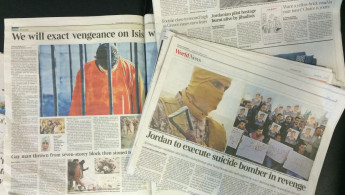How the UK press covered Lieutenant al-Kassasbeh's murder
The story of Lieutenant Moaz al-Kassasbeh's murder by the Islamic State group (IS, formerly known as Isis) was all over the front pages in the UK by Wednesday morning, following the release of the gruesome video of his killing and the Jordanian government's confirmation of his death.
Broadsheets, tabloids and websites all described the video as exceptionally horrific, saying that it went beyond previous videos of IS beheadings in its violence, theatricality and cruelty.
The Guardian noted that "even Al-Qaeda followers were horrified".
The Times said "Islamic State militants plumbed new depths in depravity last night", and that the footage "clearly intended to shock the world".
Analysts doubted that Kassasbeh ever stood a real chance of being released because his killing provided IS with greater propaganda value, Times journalists reported.
The ethics of reporting horror
The video was removed from YouTube and other sites minutes after it was posted, and British papers kept their descriptions to basic summaries of what the video depicted - Kassasbeh being burned alive while locked in a cage.
Will Gore, The Independent's deputy managing editor, discussed the important issue of how media outlets should cover IS videos. He said they present a "dilemma" for traditional media companies between recounting "every detail of the staged threats, the fluttering flags, the despicable murders" and creating "a news blackout on the basis that, by publishing stories about the depraved acts of fanatics, we are furthering their cause".
Gore emphasised that "every story should result from judicious decisions about what material to include - and to omit. But when we face the kind of monstrous fanaticism displayed by Isis, a considered response by the media takes on added significance".
A marked change
Most newspapers thought the video marked an increased brutality on IS' part. The Independent called the murder "a departure" from previous IS hostage killings.
| The graphic nature of the film, set to a religious chant and a heartbeat, goes beyond anything yet seen. - The Daily Telegraph |
The Daily Telegraph said "the graphic nature of the film, set to a religious chant and a heartbeat, goes beyond anything yet seen even from videos of hostages of beheadings, shot or stoned to death".
The conservative-leaning paper also speculated about the video's target audience. "There is no speech from the British executioner of Western hostages, known as Jihadi John, nor subtitles in English, as with videos of previous killings - perhaps a sign that this was a message being sent to the Arab world, not the West."
The Times added that this may be a new direction for IS, which now controls large swathes of Iraq and Syria.
"Burning a hostage to death signals a new tactic for the group, which has previously beheaded western hostages while releasing for ransom those whose government was prepared to pay."
Some speculated that the video would turn more people against IS. The Times thought the "brutality of Isis' actions... may have backfired", judging by the protests in Amman and in Karak, Kassasbeh's hometown.
The diplomatic editor of the Rupert Murdoch-owned paper, Roger Boynes, suggested the video indicated IS was changing from a disciplined fighting force into a "leaderless lynch mob", and that its "reign of terror" would eventually damage its own ability to recruit.
Both The Times and the Daily Mail wondered whether the idea of burning Kassasbeh may have come from Twitter - after IS followers started a campaign on the social media site asking for ideas for his murder.
The video, however, linked the deaths of people burned to death in US-led airstrikes to the "punishment" chosen for the jet fighter pilot.
| The king may become more cautious, while appealing to his people's sense of patriotism. - Ian Black, The Guardian |
Consequences for the coalition
There was general agreement in the UK press that the video would strengthen international determination to defeat IS and reinforce the US-led coalition's war against it.
However, there was no concensus on what this means for Jordan's role in the coalition. The Guardian's Middle East editor, Ian Black, thought the horror felt in Jordan could weaken public support for the coalition's war and increase dissent against King Abdullah, having a "devasting impact" on the kingdom.
"It is hard to see Jordan suddenly withdrawing from the coalition," Black wrote. "But the king may become more cautious, while appealing to his people's sense of patriotism and injured national pride."
This may be playing into the hands of IS, however. "Isis have spoken of their desire to expand into Jordan and have sought to exploit the pilot's captivity to stir up dissent against King Abdullah," reported The Times.
The Independent also warned of the consequences for Jordan - and the fact that it may now be pulled in different directions. "It is inside Jordan that the biggest threat exists," it said. "Jordan is 95 per cent Sunni Muslim, the same strand of Islam claimed by Isis, and sympathy for the jihadis has grown in economically depressed areas. Yet Jordan is one of the West's closest allies in the Middle East."
But veteran journalist and commentator Robert Fisk speculated that the incident may yet hold some advantage for the Jordanian king - and other regional figures: "There will be ruthless leaders aplenty - Bashar al-Assad of Syria comes to mind, now that we have decided that his enemies are even more horrible than him - who will benefit from the cruelty of the last few hours."



